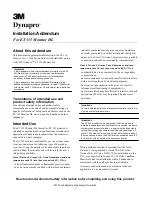
Page 36
Additional protection:
•
Frequency disturbance.
•
Reverse power.
•
Diode fault.
•
Vibration level.
NOTE: Depending on the scope of the supplied generator, only some of the
protections may be applicable in practice. Necessary level of generator
protection shall be defined by the customer and necessary items shall be
included in the generator scope on request.
6.4 Start-up procedure
Always before starting up the synchronous machine check that:
•
No shutdown procedures are in operation.
•
Personnel and equipment associated to the machine are ready to start up the
machine.
For start-up procedure, see
Chapter 5.6. Starting
.
6.5 Continuous supervision
A counter for the number of starts and a duty time meter should be included in the
system. The operating personnel should inspect the synchronous machine at
regular intervals. This means that they should listen to, touch and smell the
synchronous machine and its associated equipment in order to obtain a feeling for
normal operating conditions.
The object of the supervision inspection is to thoroughly familiarize personnel
with the equipment. This is essential in order to detect and fix abnormal
occurrences in time.
Data from the supervision inspection should be kept for future reference and can
be of help in maintenance work, trouble shooting and repairs. It is also
recommended that the operational data (generator load, power factor, speed,
voltage and current as a minimum) shall be recorded and stored for future
reference.
The difference between supervision and maintenance is rather vague. Normal
supervision of operation includes logging of operating data such as load,
temperatures etc., and the comments are used as a basis for maintenance and
service.
•
During the first period of operation (<200 h) supervision should be intensive.
Bearing and winding temperatures, load, current, cooling, lubrication, and
vibration should be checked frequently. The bearing temperatures and
lubrication should be monitored closely, see
Chapter 5.7.1. Bearings with re-
lubrication option
•
During the following duty period (200-1000 h) a check-up once a day is
sufficient. A record of supervision inspection should be used and filed. If
operation is continuous and stable, the time between inspections may be
further extended.
















































